For the Wellness Score, measurements for the Cervical Compression, Kemp's and Nachlas tests will be entered as you would for a Pain Scale of 0-10, with 10 being the worst pain possible, or as the inability to tolerate the test. We have also included an Ortho Test [Custom] parameter that you can apply to any orthopedic test of your choice that reproduces pain.
Kemp's Test: The purpose of this test is most commonly used to assess the lumbar spine for facet joint pain. The provocation of local pain indicates facet dysfunction, while radiating pain may suggest nerve root irritation. While this Wellness Score parameter allows the examiner to note the level of pain on 0-10 pain scale, whether the pain is local, or radicular with numbness and tingling, should be documented in the examiner's notes.
The Kemp Test test may be performed with the patient either in the seated or standing position.
Standing position:
1. The patient is standing before the doctor. The doctor stands behind the patient.
2. The doctor stabilizes the opposite ilium from the side being tested with one hand.
3. The other hand contacts the shoulder of the patient and leads the patient to extension, ipsilateral flexion and ipsilateral rotation.
4. Hold this position for three seconds.
Seated position:
1. The patient is seated with arms crossed over the chest.
2. The doctor stands behind the patient. One hand of the doctor stabilizes the patient’s lumbosacral region on the side to be tested.
3. The other arm controls the patient’s upper body movement.
4. The patient is passively directed into flexion, rotation, lateral flexion, and extension.
5. Depending on the patient’s response, axial compression may be applied in the fully extended and rotated position to increase stress on the posterior joints.
The test is positive when the patient reports pain, numbness or tingling in the area of the back or lower extremities. The pain is located on the side being tested.
Cervical Compression (Spurling Test, Maximal Cervical Compression Test, Foraminal Compression Test, Neck Compression Test, Jackson): While there are variations of how this test is performed, the outcome that is being assessed is the presence of pain and radiculopathy. For the Wellness Score, measure the pain on a 0-10 scale (with 10 being worst) and note radicular symptoms in the chart notes.
Nachlas Test: This test aims to assess injury (sprain, irritation, inflammation) of the sacroiliac joint. The patient is prone on the exam table and the doctor passively flexes knee joint by bringing the patient's heel to the ipsilateral buttock. The doctor will notate the level pain (0-10, with 10 being worst) in the Wellness Score.
[Custom] Orthopedic Test: Use this parameter for any orthopedic test not currently in our list to record a pain level. Note in your chart which test you are using the custom assessment for, such as Yeoman's, Hibbs, etc). The parameter is measured on a pain scale of 0-10, with 0 being no pain reproduced and 10 being the highest level of pain. The Ortho Test-[Custom] in the parameter list is there for you to use and apply to any orthopedic test used to provoke pain. Be sure to label the test used in your notes so that you can repeat the test later for comparison reports.
The Orthopedic Test parameter in the Wellness Score is a generic test rating that you can use for any orthopedic test that reproduces pain or discomfort.
You can also use this data table to create and name your parameter: How do I create a new Parameter? If the patient is unable to tolerate the positioning of the orthopedic test, they would be given a score of 10, which is an automatic fail. If the patient is able to tolerate the test position, but not the test itself, they would be given a score of 9, also an automatic fail. A score of 0 is the best possible score, as the patient is able to perform the orthopedic test without any dysfunction or discomfort. When performing the orthopedic test, ask your patient to rate the pain or discomfort of the test on a scale of 0-10, 0=no pain or discomfort, 10=extreme pain. Make note of any radicular symptoms in the patient's chart.
Use the chart below to determine the score:
Resources:
- Craig E. Morris; Low Back Syndromes; McGraw-Hill Professional; 2005
- Souza TA. Differential Diagnosis and Management for the Chiropractor: Protocols and Algorithms. Jones & Bartlett Publishers; 2009 Oct 7.

